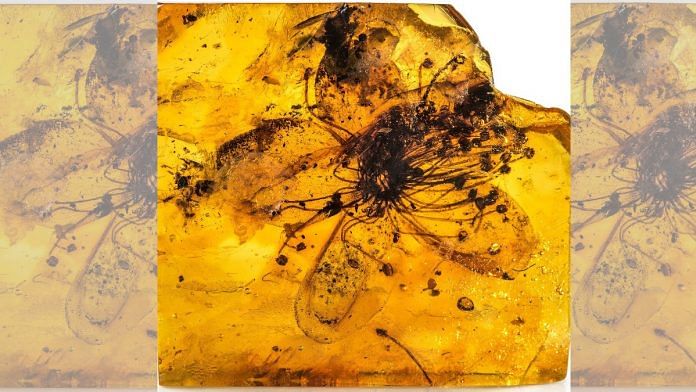Bengaluru: Pollen extracted from the world’s largest-ever flower preserved in amber — discovered over 150 years ago in north-central Europe — has strong affinities to an Asian species of flowering plants, scientists have found.
The fossilised flower, measuring 2.8 cm across — nearly three times larger than typical ancient flowers — dates back nearly 40 million years.
The findings were published in the peer-reviewed journal Scientific Reports Thursday.
Amber is a fossilised version of resin, which typically comes from coniferous trees. When resin oozes out of trees, it preserves a specimen by completely covering it. The resin also needs to protect the specimen from oxygen and microbes before hardening into amber to prevent decomposition of the biological specimen inside.
The scientists from Germany and Austria estimate that this flower was instantly covered with a large quantity of resin as soon as it bloomed for the first time, preserving the flower perfectly along with its pollen.
The fossil was first discovered in 1872 from the boreal forests in north-central Europe and kept in a collection in the Federal Institute for Geosciences and Natural Resources, Germany.
Back in the 19th century, when it was first studied, its pollen wasn’t examined and it was thought to be the the flower of the ancient species Stewartia kowalewskii. But after extracting its well-preserved pollen, scientists have concluded that it is a closer relative of vegetation found today in Asia. It is, now, identified as the species Symplocos kowalewskii.
The findings provide a rare window into the past of the Baltic forests, which today are cold and wooded. Based on the findings, scientists conclude that in the past, this area would have been a warm and humid area with swamps. These trees saw large outpourings of resin, which was then perfectly able to encapsulate a newly bloomed flower into amber.
The flower is dated to the Late Eocene epoch — between 38 million to 33.9 million years ago.
“Such fossilised flowers are rare. Fossilised botanical material is rare in itself, and fully bloomed flowers with intact pollen have hardly been found before inside amber,” authors Eva-Maria Sadowski & Christa-Charlotte Hofmann, said in the paper
The revision of the fossil and its reexamination represents the first ever-record of the Symplocaceae family from Baltic amber, and supports the findings of past Baltic flora being related to present day forests of East and Southeast Asia.
(Edited by Anumeha Saxena)
Also Read: Earth’s ozone layer on way to recovery, finds UN report, should mend by 2040



